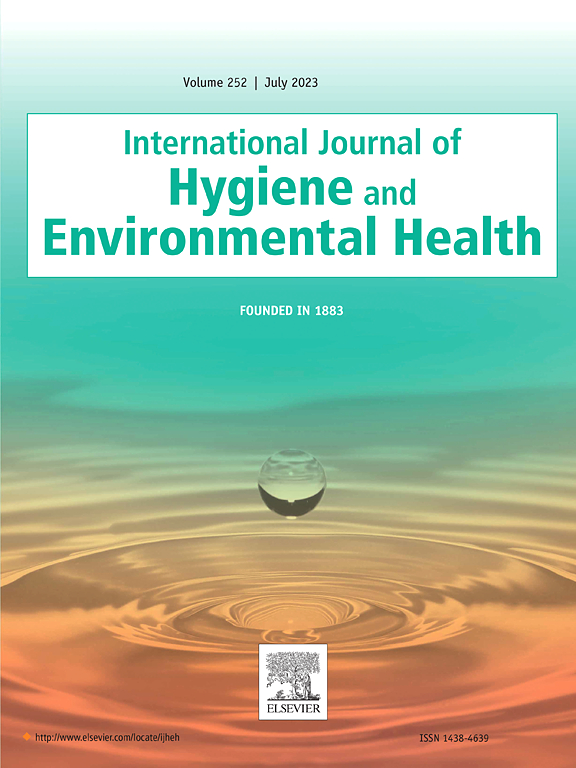Associations of personal care product use during pregnancy and the postpartum period with markers of postpartum glycemic control – Results from the ERGO Study
IF 4.4
2区 医学
Q1 INFECTIOUS DISEASES
International journal of hygiene and environmental health
Pub Date : 2025-03-29
DOI:10.1016/j.ijheh.2025.114569
引用次数: 0
Abstract
Background
Personal care products frequently contain endocrine disrupting chemicals (EDCs) including parabens and phthalates, which can alter glucose metabolism. The postpartum period is a time of rapid metabolic change, but whether EDC-associated product use impacts postpartum glucose metabolism is unknown.
Methods
We included 270 participants from the Boston, MA-based Environmental Reproductive and Glucose Outcomes (ERGO) pregnancy cohort with data on self-reported personal care product use at ≤4 pregnancy visits (median: 11, 19, 26, 36 weeks of gestation) and 1 postpartum visit (median: 9 weeks). We quantified postpartum hemoglobin A1c (HbA1c), fasting insulin, fasting- and 2-h glucose post-75-g oral glucose tolerance test, and calculated homeostatic model assessment for insulin sensitivity (HOMA2-S) and beta-cell function (HOMA2-B). Using covariate-adjusted linear regression, we estimated visit-specific associations of product use with postpartum glycemic outcomes.
Results
Associations of product use with postpartum glycemic measures were mixed. Users of certain hair products had lower postpartum insulin sensitivity compared to non-users (e.g., Visit1 hair gel/spray: 22.8% difference [95% CI: 39.2, −1.9] in mean HOMA2-S). Conversely, users of products like deodorant, liquid- and bar soap, had higher insulin sensitivity and lower glucose levels (e.g., postpartum deodorant: 32.1% difference [95% CI: 7.0, 63.1] in mean HOMA2-S; −3.1 mg/dL [95% CI: 6.3, −0.04] mean fasting glucose). Associations with other products were inconsistent across timepoints or null.
Conclusion
Use of certain personal care products during the perinatal period was associated with altered postpartum glucose metabolism. Larger studies are needed to understand the impacts of product use patterns on glycemic outcomes.

孕期和产后使用个人护理产品与产后血糖控制指标的关系——来自ERGO研究的结果
个人护理产品通常含有内分泌干扰化学物质(EDCs),包括对羟基苯甲酸酯和邻苯二甲酸酯,它们可以改变葡萄糖代谢。产后是代谢变化迅速的时期,但edc相关产品的使用是否会影响产后葡萄糖代谢尚不清楚。方法:我们纳入了来自马萨诸塞州波士顿的环境生殖和血糖结局(ERGO)妊娠队列的270名参与者,他们在妊娠≤4次就诊(妊娠11、19、26、36周)和产后1次就诊(妊娠9周)时自我报告个人护理产品的使用情况。我们量化了产后血红蛋白A1c (HbA1c)、空腹胰岛素、75 g后空腹和2小时葡萄糖口服葡萄糖耐量试验,并计算了胰岛素敏感性(HOMA2-S)和β细胞功能(HOMA2-B)的稳态模型评估。使用协变量调整的线性回归,我们估计了产品使用与产后血糖结局的访问特异性关联。结果产品使用与产后血糖测量的关联是混合的。与不使用某些护发产品的人相比,使用某些护发产品的人产后胰岛素敏感性较低(例如,Visit1发胶/发胶:平均HOMA2-S差异为22.8% [95% CI: 39.2,−1.9])。相反,使用除臭剂、液体皂和香皂等产品的人,胰岛素敏感性较高,血糖水平较低(例如,产后除臭剂的平均homa - s差异为32.1% [95% CI: 7.0, 63.1];- 3.1 mg/dL [95% CI: 6.3, - 0.04]平均空腹血糖)。与其他产品的关联在时间点上不一致或为零。结论围产期使用某些个人护理产品与产后糖代谢改变有关。需要更大规模的研究来了解产品使用模式对血糖结果的影响。
本文章由计算机程序翻译,如有差异,请以英文原文为准。
求助全文
约1分钟内获得全文
求助全文
来源期刊
CiteScore
11.50
自引率
5.00%
发文量
151
审稿时长
22 days
期刊介绍:
The International Journal of Hygiene and Environmental Health serves as a multidisciplinary forum for original reports on exposure assessment and the reactions to and consequences of human exposure to the biological, chemical, and physical environment. Research reports, short communications, reviews, scientific comments, technical notes, and editorials will be peer-reviewed before acceptance for publication. Priority will be given to articles on epidemiological aspects of environmental toxicology, health risk assessments, susceptible (sub) populations, sanitation and clean water, human biomonitoring, environmental medicine, and public health aspects of exposure-related outcomes.

 求助内容:
求助内容: 应助结果提醒方式:
应助结果提醒方式:


